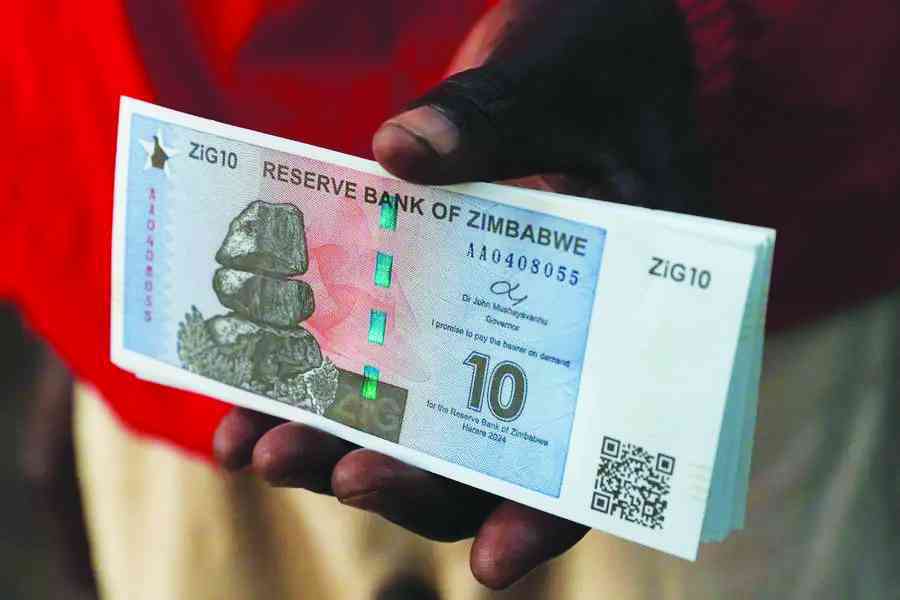
THE Reserve Bank of Zimbabwe (RBZ) launched the new currency, Zimbabwe Gold (ZiG), over four months ago. Zimbabwe Gold is a structured currency backed by a composite basket of foreign currencies and precious metals (principally gold).
The new currency was introduced to tackle the country’s economic challenges, particularly inflation and exchange rates volatility.
This is achieved through anchoring the ZiG's value to a basket of stable assets and linking money supply growth to assets growth. Developments in the economy since the inception of ZiG currency can be assessed using different variables.
Before the introduction of ZiG, Zimbabwe had adopted blended/weighted inflation as official inflation statistics through Statutory Instrument (SI) 27 of 2023.
Inflation was relatively high during that time, year-on-year weighted inflation rate for March 2024 was at 55,3% and month-on-month inflation rate was at 4,9%.
The introduction of ZiG resulted in Zimbabwe migrating from (SI) 27 of 2023, the country is now producing three price indices, the ZiG index, US dollars index and weighted index.
ZiG month-on-month inflation rates for May, June and July 2024 stood at - 2,4%, 0,0% and -0,1% respectively.
Blended month-on-month inflation rates for May, June and July 2024 were -0,6, -0,2 and -0,1, respectively, way lower than 4,9% recorded in March 2024 before ZiG introduction.
- Rampaging inflation hits Old Mutual . . . giant slips to $9 billion loss after tax
- Monetary measures spur exchange rate stability: RBZ
- Zim deploys IMF windfall to horticulture
- Banker demands $21m from land developer
Keep Reading
The US dollar month-on-month inflation rates for May, June and July 2024 were 0,1%, -0,3% and -0,1 respectively.
Inflation rates prevailing in the economy as measured by all three indices are low and weakly preferred.
Prior to the introduction of ZiG currency, the moribund Zimbabwean dollar (ZWL) had depreciated considerably.
The ZWL currency lost around 70% of its value on the official market between January 2024 and March 2024, trading at around ZW$30 000 per USD.
On the parallel market, the exchange rate of the ZWL to the US dollar was around ZW$40 000.
The ZiG started trading on April 8 2024, with an initial official exchange rate of ZiG13,56 to the US dollar. The average exchange rate for May, June and July 2024 was 13.58 ZiG to the dollar
This speaks to a stable exchange rate on the official market.The worrisome development on the black market is that the ZiG has depreciated by around 35%, trading at around ZiG19/20 to the US dollar.
The general population turns to the parallel market for US dollars because they are not readily available in banks and bureau de-changes in exchange of ZiG balances equivalent.
The demand for US dollars is a function of some goods and services such as fuel, rentals and passports being priced exclusively in US dollars.
The disparity between the official and the parallel market exchange rates creates arbitrage opportunities which contradict efficient market operations.
When ZiG was introduced, about 85% of transactions in the economy were in US dollars and 15% in local currency.
With ZiG acceptability in the economy, the proportion of transactions being conducted in local currency doubled to 30%.
This shows that ZiG currency demand for transactional purposes in theeconomy is being met.
At ZiG’s infancy, small denominations were in short supply, which resulted in shortage of change.
This resulted in some prices, particularly, local trips bus fares being rounded upwards from US$0,50 to US$1,00 for transactional convenience.
To that effect, the RBZ intervened by introducing ‘swipe for ZiG cash facility’ with HomeLink.
Economic agents swipe for ZiG cash using local currency debit/credit cards.
This has resulted in improved availability of ZiG small denominations in the economy.
In a disquieting development, some traders are forcing consumers to pay exclusively in US dollars. The common phrase that is being used by these traders is “swipe is down at the moment”.
This forces the transacting public to use US dollars only or to acquire them on the parallel market at a premium. Positive developments have been observed in the economy since the inception of ZiG currency.
However, monetary authorities ought to remain resilient and monitor developments in the economy for timely policy responses for ZiG success.
The RBZ’s Financial Intelligence Unit (FIU) should continue monitoring suspicious transactions such as movement of large sums of money daily.
The FIU should also conduct spot visits consistently targeting shops that are rejecting ZiG, hiding behind swipe network challenges.
Some shops are openly highlighting to customers that certain products are only sold in US dollars.
Exchange rate manipulation is also evident in some shops.
This also calls for consistent strict monitoring.
The general sentiment is that monitoring is intensified during the first days of policy announcement and the energy to monitor dwindles afterwards.
A monthly report on FIU monitoring activities should be produced and made available to the public.
The central bank should continue accumulating reserves, backing the local currency.
With adequate reserves, the RBZ intervenes timeously in the foreign exchange market to smoothen exchange rate oscillations.
Zimbabwe had about US$570 million worth of reserves when the ZiG currency was launched. As at July 2024, the stock of reserves is now four times cover of reserve money.
Accumulating adequate foreign currency reserves is a process which requires addressing structural challenges in the economy.
Upscaling domestic production has pass-through effects leading to import substitution, which reduces foreign currency outflow.
The average merchandise monthly import bill for Zimbabwe is around US$ 700 million.
With import substitution, foreign currency leakage is minimised with savings channeled towards reserves.
To preserve ZiG value, the RBZ should manage payments being made to contractors by the government.
Zimbabwe has witnessed enormous construction and road rehabilitation works in recent times and the work is expected to continue in the foreseeable future.
Some contractors offload local currency to the black market, which exerts pressure on the exchange rate.
The formal market is not adequately providing for all foreign currency requirements to various players in the economy.
As such, it has been observed that each time contractors are paid, blackmarket exchange rates shoot up.
Contractors should be paid in batches or receive part of their payments in US dollars so that they do not hold excess ZiG balances.
The FIU should monitor contractors’ transactions and descent heavily on those channeling funds to the black market.
A tight monetary policy position helps to stabilise ZiG value by ensuring that excessive money supply growth is abated. In the 2024 monetary policy statement (MPS) presentation, the governor assured the nation that money supply growth will be in line with growth in reserves.
The central bank should religiously implement this as it helps to control inflation and exchange rates pass-through effects.
Money supply growth and reserves growth statistics should be availed to the public consistently as it is a confidence building measure.
A month or two months without these critical statistics diminishes public trust and confidence, which might have implications on currency stability.
Most people, who are engaging in unofficial foreign currency trading, view it as a source of employment.
They engage in rent-seeking activities as their exchange rates manipulation is not backed by any fundamentals.
If the disparity between the official and the parallel market is wide, arbitragers make huge profits through currency trading.
Creating opportunities for the unemployed will remove them from the streets and deter them from illegal foreign currency trading.
Exchange rate movement should be driven by fundamentals, not rent-seeking tendencies.
The government should arrange subsidised training courses for the unemployed and come up with suitable financing models for start-up capital.
The introduction of Zimbabwe Gold (ZiG) has led to lower inflation rates and a stable official exchange rate.
However, challenges remain, such as depreciation in the parallel market and limited availability of US dollars.
The Reserve Bank of Zimbabwe (RBZ) has taken measures to address these issues, but ongoing efforts are needed to ensure long-term stability and success of the ZiG currency.
- Nyabunze is an economist and writes in his personal capacity. These weekly New Perspectives articles, published in the Zimbabwe Independent, are coordinated by Lovemore Kadenge, an independent consultant, managing consultant of Zawale Consultants (Pvt) Ltd, past president of the Zimbabwe Economics Society and past president of the Chartered Governance & Accountancy Institute in Zimbabwe (CGI Zimbabwe). — kadenge.zes@gmail.com or mobile: +263 772 382 852.










